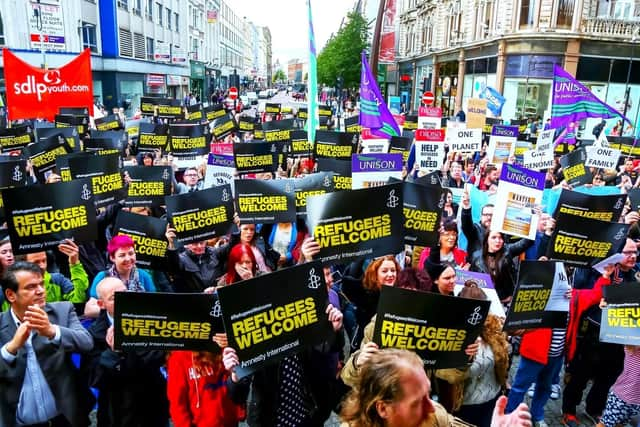Belfast taking in more asylum seekers per head of population than almost any other UK council area, Home Office immigration data shows
and live on Freeview channel 276
The numbers reveal how many asylum seekers the Home Office is supporting across every UK council (including those whose claims have failed).
They show that out of 364 councils in the UK, Belfast has the fourth highest proportion of asylum seekers.
Advertisement
Hide AdAdvertisement
Hide AdAs of the end of September, the total was 2,498 (with the total for all of Northern Ireland being 3,220).


That is 0.72% of the city's population.
To put that in context, the top five UK council areas with the highest proportion of asylum seekers are:
1: Hillingdon (London): 0.85%
2: Halton (Merseyside): 0.76%
3: Hounslow (London) and Glasgow jointly: 0.74%
4: Belfast: 0.72%
5: Coventry: 0.63%.
This does not include people coming under the 'Homes for Ukraine' scheme (of which there were 1,298 arrivals in NI over the past year).
Nor does it include Afghans who helped the British Army and are being resettled in the UK (of which there are currently 94 in NI).
Advertisement
Hide AdAdvertisement
Hide AdIf you add these Ukrainians and Afghans to the general asylum list, then the number in Belfast rises to 2,708 people (0.78% of the city's population).
The figures were published in late November by the Home Office.
They further show that, of Belfast's 2,498 asylum seekers, some 759 were in "contingency accommodation" – meaning mainly hotels – with the rest put up in normal housing.
But whilst Belfast has a high proportion of asylum seekers, the rate for Northern Ireland as a whole is 0.17% - just below the UK average of 0.18% – and other Northern Irish councils have comparatively few: for example, Fermanagh & Omagh and Mid Ulster have literally zero asylum seekers.
Advertisement
Hide AdAdvertisement
Hide AdIt is worth noting that, given the size of the waiting list for social housing in Northern Ireland, the number of asylum seekers in the country would have a relatively tiny impact on it.
Right now, about 46,000 households are on the social housing waiting list, whereas the number of individual asylum seekers who are occupying general housing stock in Northern Ireland is 2,075.
However, these latest figures do come in the wake of a renewed focus on immigration on both sides of the Irish border.
The stabbing of three children and a school assistant by an immigrant in Dublin last week sparked rioting and a national debate on immigration (particularly given the republic's dire housing shortage).
Advertisement
Hide AdAdvertisement
Hide AdAnd this week the PSNI declared that it was treating signs that had appeared in Suffolk, a loyalist-dominated enclave in west Belfast, as a "hate incident" (meaning something which falls short of being a crime, but which police will investigate anyway).
The signs said: "NI Housing Executive and private landlords take note: Suffolk will no longer accept the re-housing of illegal immigrants and the excrement of other communities."
Identical signs had been spotted in Belvoir, another loyalist/unionist-dominated estate in south Belfast, a few weeks earlier.
At that time South Belfast MLA Edwin Poots had said the signs were "wrong and inappropriate" but that "many, many people who've lived there for a couple of generations now... want their family to continue to live in that area", and have to watch as others jumped ahead of them on the waiting list.
Advertisement
Hide AdAdvertisement
Hide AdHe also said the reference to "the excrement of other communities" meant tenants who had been "intimidated out of other areas because they've been engaged in anti-social activity".
Asylum seekers are, unless an exception is made, unable to do paid work.
The government says that they will be given somewhere to live (though they have no say in where this is) and will usually get £47.39 per week for each person in their household, loaded onto a type of debit card called an ASPEN card, with a small top-up if they are pregnant or have young children.
Asylum seekers can also get six months of free public transport.
Advertisement
Hide AdAdvertisement
Hide AdChildren from five to 17 will be sent to school, and medical care will be provided on the NHS.
If someone is refused asylum the government says “you must return to your country as soon as possible”, but while still in the country, these financial support and living arrangements stay essentially the same.